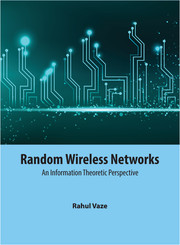Book contents
- Frontmatter
- Dedication
- Contents
- List of Figures
- Preface
- Acknowledgments
- Notation
- 1 Introduction
- 2 Transmission Capacity of ad hoc Networks
- 3 Multiple Antennas
- 4 Two-Way Networks
- 5 Performance Analysis of Cellular Networks
- 6 Delay Normalized Transmission Capacity
- 7 Percolation Theory
- 8 Percolation and Connectivity in Wireless Networks
- 9 Throughput Capacity
- Index
- References
5 - Performance Analysis of Cellular Networks
Published online by Cambridge University Press: 05 May 2015
- Frontmatter
- Dedication
- Contents
- List of Figures
- Preface
- Acknowledgments
- Notation
- 1 Introduction
- 2 Transmission Capacity of ad hoc Networks
- 3 Multiple Antennas
- 4 Two-Way Networks
- 5 Performance Analysis of Cellular Networks
- 6 Delay Normalized Transmission Capacity
- 7 Percolation Theory
- 8 Percolation and Connectivity in Wireless Networks
- 9 Throughput Capacity
- Index
- References
Summary
Introduction
In this chapter, we consider cellular wireless networks and apply the tools from stochastic geometry to get some critical insights and almost closed-form results for several important performance measures, such as connection probability, mean rate of communication, call-drop probability, that for long have evaded analytical tractability. Traditionally, these parameters are either computed for very simple and unrealistic models or using large scale Monte–Carlo simulations that are environment-specific.
The breakthrough is made possible because in the modern paradigm, many different types of basestations are overlaid on top of each other, and the overall basestation deployment closely resembles a uniformly random basestation deployment. In the new paradigm, three different types of basestations, the macro basestation, the femto basestation, and the pico basestation, all operate at the same frequency. The location of macro basestations is controlled by cell operators, while the femto and pico basestations are deployed by users in an arbitrary manner with no centralized control over their locations. Thus, the overall basestation locations resembles a uniform deployment model, where the basestations are deployed uniformly at random locations within the area of interest. Modeling cellular network with random basestation locations enables us to explicitly find, for example, the connection probability of any user, the average transmission rate or the call drop probability using stochastic geometry results.
In this chapter, we also address another limitation made for cellular network analysis of modeling the shadowing loss because of blockages (trees or buildings) as a single loss-parameter at the receiver, which is independent of the length of the transmitter–receiver link. Although this assumption helps in the analysis and simulations, it is grossly inaccurate, since shadowing loss is distance-dependent. Larger the distance between the basestation and the mobile user, larger is the number of buildings and trees obstructing the communication. Moreover, the loss is also different for signals from different basestations.
To overcome this limitation, we consider a propagation model that assumes that the blockages are located uniformly randomly in the field of interest.
- Type
- Chapter
- Information
- Random Wireless NetworksAn Information Theoretic Perspective, pp. 95 - 115Publisher: Cambridge University PressPrint publication year: 2015

